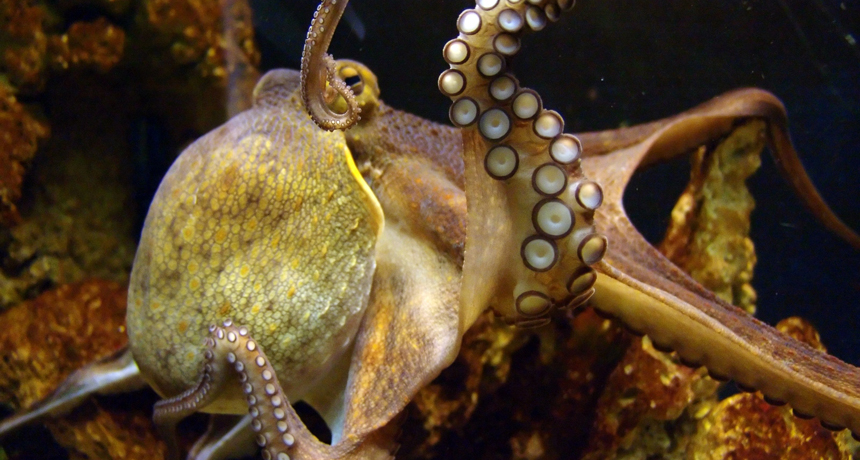How an octopus keeps itself out of a tangle

The suckers on an octopus stick to just about anything, but they don’t stick to octopus skin. A new study suggests that a chemical in the animals’ skin inhibits attachment.
Joachim S. Müller/Flickr (CC BY-NC-SA 2.0)
- More than 2 years ago
The common octopus is amazing. It can swim fast, or creep slowly across the ocean floor. It can spread out to a large size or pack itself into the tiniest of spaces. It can change its coloring to mimic its surroundings (and one of its relatives can even mimic other creatures). The octopus can regrow any of its eight arms if one gets severed. And it’s clever, figuring out how to open jars, even when trapped inside. But the common octopus is also a freak: The animal is a cannibal and will sometimes even eat its own severed arm.
But for all that we know about the octopus, there’s been one big question left unanswered: Why don’t octopuses’ suckers stick to themselves? Now Nir Nesher of the Hebrew University of Jerusalem in Israel and colleagues think they’ve figured it out. The animals must have a chemical in their skin that inhibits attachment, they report May 15 in Current Biology.
The researchers began with severed octopus arms, which continue to act like they’re alive for an hour or so after detachment. These arms would only grab other amputated arms when those arms had been skinned. That led the scientists to think that there was something in the skin that signaled “octopus” to the suckers. They then coated Petri dishes in skin extract. The severed arms grabbed the Petri dishes much more loosely when covered in the extract than when covered with an extract of fish skin or a control substance.
Nesher and colleagues also videotaped live octopuses presented with severed arms to see what would happen. In some instances, the octopuses would treat the arm like a typical piece of prey, grabbing it and manipulating it with its arms, them bringing it to its mouth. “But in others, octopuses showed a behavior uncharacteristic of feeding,” the researchers note. “When presented with amputated arms, the octopus would repeatedly rub its arms over the amputated arm, touching it, but not attaching to it or grabbing it.” Other times, the octopus would only grab the arm at the site of amputation, where there was no skin.
The octopuses appear to know when an amputated arm belongs to itself: They attached themselves to the severed arms of other octopuses about 95 percent of the time but only in 40 percent of trials that involved their own arms. And about three-quarters of the animals treated other individuals’ arms as food but only a quarter did so with their own. (But still — ew.)
When an arm was skinned, though, it was always treated as a typical piece of food, regardless of it was its own arm or one from another octopus, the researchers write.
The results suggest that there is something in the skin that tells the octopus that the object they are touching is an octopus. And while severed arms always avoided attaching to octopus skin, live octopuses didn’t, which indicates they probably have the ability to override that initial signal, the researchers write.
The signaling system may help the animals with motion control. It’s already known that they simplify motor control of their many arms by limiting the degrees of freedom for them to just three and through the use of “predefined motor programs” embedded in the neuromusculature of the arms themselves. Having an easy way for the suckers to be able to identify “octopus” and “self” may be another method for simplifying the complications that come with eight-limbed life.
A common octopus grabs an amputated arm, but only at the site of amputation, where there is no skin. Even after 20 minutes, the octopus held the arm in its mouth only at that skinless site.
Credit: N. Nesher et al./Current Biology 2014





